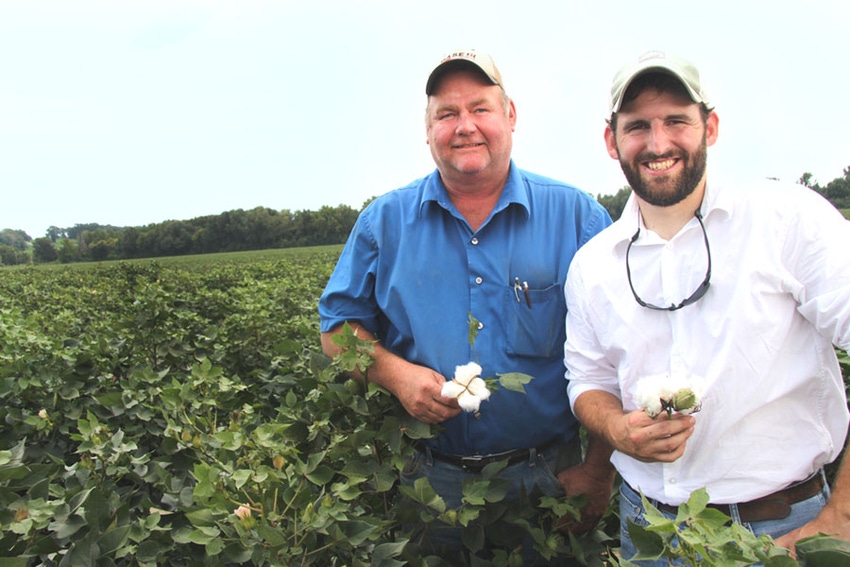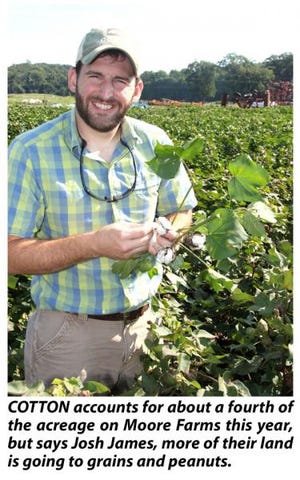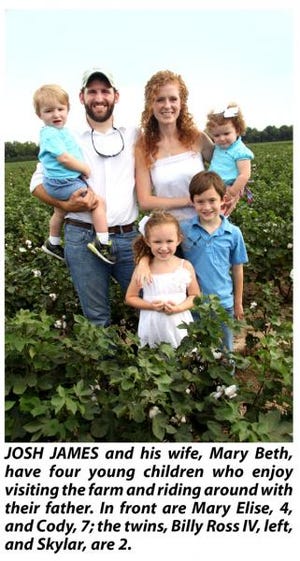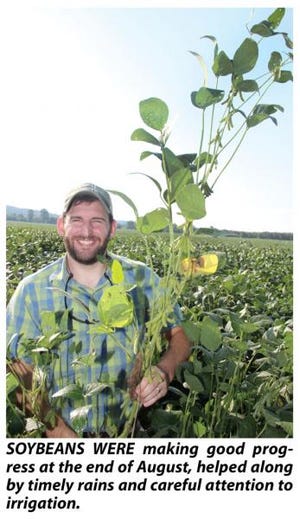
“We’ve got about 1,000 acres of cotton this year,” says Josh James, who farms with his uncle, Walt Moore in Tallahatchie County, Miss. “But, we’ve cut ‘way back in favor of grains, and this year, for the first time, peanuts. Grain prices have been a factor in the cotton cutbacks, but Uncle Walt has always wanted to get more diversity into our operation, and we’ve been able to move in that direction with corn and peanuts.”

Cotton accounts for about one-fourth of the acreage this year at Moore Farms, located in Tallahatchie County, Miss., at the eastern edge of the Delta along the bluff hills — but that’s a sharp drop from 85 percent four or five years ago.
“We’ve got about 1,000 acres of cotton this year,” says Josh James, who farms with his uncle, Walt Moore. “We’ve cut ‘way back in favor of grains, and this year, for the first time, peanuts. Grain prices have been a factor in the cotton cutbacks, but Uncle Walt has always wanted to get more diversity into our operation, and we’ve been able to move in that direction with corn and peanuts.”
With corn harvest under their belts, he breaks into a broad grin when asked about yield.
“We had 550 acres this year, all Pioneer 1615, and bar none, it’s the best corn I’ve ever seen. We were done harvesting in late August, with an average of about 220 bushels. On the dryland part of one odd-shaped field where the pivot doesn’t reach, we were cutting about 100 bushels, but on some of the watered portion the yield monitor was showing 335 bushels per acre — which is absolutely phenomenal!
“In years past, we’ve averaged about 175 bushels, with some fields going 200 or better.
“All our corn is irrigated, some under two center pivots, the rest furrow. We got all of it planted early before the spring rains, and then we got some good rains during the season. We really stayed on top of our watering this year and put all the corn on stronger ground. Everything has just some together well.”
About one-third of their land is irrigated, with the majority of that furrow. They have three center pivots, all Valley; one covers 80 acres, another 175 acres, and the one added this year covers 300 acres.
“While water is still plentiful at shallow depths here in the Delta, we all know that we need to make more efficient use of this resource,” Josh says. “At young farmer meetings in recent years, most of the talk has been about marketing, but this year it was all about water and what an important — and serious — issue it is.
“Here on our farms, our plan is to continue to expand our irrigation capability. We pump from wells and also relift water from a pond.”
They harvest corn at about 17 percent moisture, which then requires only minimal drying. They have 60,000 bushels of grain storage in two bins, and plan to add two more bins this year, doubling capacity to 120,000 bushels.
“We believe putting our money into additional irrigation and storage offers a greater return on our investment than anything else right now,” Josh says.
As August ebbed into September, they were expecting to start defoliation as soon as rains from Hurricane Isaac moved out of the area — “about the same time we hope to start digging peanuts,” he says, noting that “this year’s cotton crop has done well.”
“We have Stoneville 5288B2F and 4145LLB2, which is a LibertyLink variety. We also have Deltapine 0912 B2RF, and Deltapine 1137 B2RF. This is our fourth year for the 0912, and we’ve really loved this variety. It has performed well for us.
“Last year we had some Deltapine 1048 B2RFcotton, which developed a lot of four bract squares. We really had to nurse it, but it was still one of our best-yielding varieties in 2011.”
Their year-in, year-out cotton average is about 2.5 bales, he says.
Problems with resistant pigweed
“Resistant pigweed is our biggest problem. Ignite has been fairly effective when we can get it on plants while they’re small, but once they get fairly big it just stunts them. This year, we’ve hired a crew to come in and hack them out with hoes and machetes. It’s an added expense, but we don’t want to let this weed get any worse.
“Except on pigweed, Roundup is still an effective herbicide for us. We’ve had some glyphosate-resistant ryegrass, but have been able to control it with a higher rate.”
Their picker is a Case IH CPX 620. “We tested one of the new module builder pickers last year,” Josh says, “but with our outlook for less cotton, we’re just don’t feel we can justify that kind of investment.
“It’s hard to say now what we’ll do in terms of cotton next year — a lot will depend on prices for cotton versus grains and peanuts. We’ll continue to have some cotton because we’re shareholders in Yalobusha Co-op Gin, which ginned about 20,000 bales last year. But as things stand now, I think we’ll cut back even more next year.”
Their cotton is marketed through Staplcotn and, he says, “Uncle Walt handles marketing of the other crops.”
They have 1,700 acres of soybeans this year, all late Group IV and early Group V.
“We planted Asgrow 494 Liberty Link soybeans, Pioneer 95Y10, and AgVenture 50KS, all in twin rows. This is the first year we’ve given Liberty Link beans a real try. We’ve already cut about 400 acres, and we’re really pleased with how they’re turning out.
“Under the center pivots, we’ve been cutting 60 to 65 bushels; on our dryland beans that got hit by drought we’re getting around 30 bushels.” They have Case IH 7088 combines.
For their fertility program, Josh says, “This is the fourth year we’ve been using poultry litter and it has worked really well, particularly on our sandier soils. The first year, we applied 2 tons per acre, and since then 1 ton. This year, we tried some liquid litter. With corn and cotton, we sidedress with 30-0-5 liquid nitrogen.” They base fertilization on soil tests.
Insects and diseases haven’t been much of a problem in any of their crops this year, he says. “We’ve sprayed some for plant bugs, and we’ve made a couple of insecticide applications on our peanuts. We’ve had just a tiny bit of white mold, and we made a couple of fungicide applications, mostly as a preventive measure.
“I admit that I wasn’t very enthusiastic about the crop, but Uncle Walt came in one day and said, ‘I’ve just bought a digger and a combine, so I guess we’re in the peanut business.’”
Peanuts for rotation, diversity
Walt says he had been interested in peanuts for several years, primarily for the diversification/rotation benefits. “But the contract price being offered was also an incentive,” he says.
“We’ve enjoyed growing the crop this year,” Josh says, “and we like that peanuts can get by on less water and seem to take stress better than corn and soybeans. They’re looking good now, and I’m anxious to dig them and see how they turn out.”
They’re growing 300 acres of the GA06 variety under contract with Birdsong Peanuts. They were planted April 23.
They planted 700 acres of wheat this past winter as a cover crop on some of their more erodible land in the hills. “We harvested only about 100 acres of it for seed,” Josh says, “and then we sprayed the rest and left it in the field as a moisture conservation measure. It worked really well, and we’ll probably continue to do this.
“We’re trying to get back to no-till on much of our land, but in order to get everything lined up for RTK, we’re doing subsoiling and then getting rows straight.
“Our tractors are all Case IH, except one; we have 275s, 255s, and 245s. Our big sprayer is a Case IH SPX3185. We try to make as many applications as we can with the sprayer to hold the line on aerial application costs.
“Some of our tractors have RTK, our sprayer has a guidance system, and our combine has a yield monitor. We love the guidance systems on the tractors; we can even run at night if we need to.
“With auto-steer, I can get so much more done, with no gaps. Everything is so precise — it’s a great tool. With the sprayer, for example, I didn’t realize how many times I was stopping to count rows and realign the machine. This is so much more efficient.
“When we’re rowing up, we don’t get exhausted from trying to keep a straight line in the field. It really takes a lot of pressure off when you’re driving one of these machines all day; I’m much less fatigued at the end of the day. And [he smiles] with four young children at home, I need to conserve as much energy as I can.”
He and wife, Mary Beth, who is in the agricultural lending department at Regions Bank, are parents of Cody, 7, Mary Elise, 4, and two-year-old twins, Billy Ross IV and Skylar.
And, says Josh, one of his most useful tools is his HTC Android smart phone. “I love it; it’s such a versatile device. In addition to all the phone/Internet/text functions, I can monitor the pivots, I have all our field maps on it, I can watch satellite and radar weather and know exactly where weather systems are, I keep chemical rates and other data on it, I can make photos and even videos, and of course, get real time markets information. It’s an absolutely great tool. I couldn’t get along without it.”
He says they hired two new employees this year, and “they’ve been a great addition to the operation. Both had previous farming experience, and we’re glad to have them. We have four full-time employees.”
Josh’s grandfather, Billy Ross James, and his father, Billy, Jr., both deceased, were farmers in the Gore Springs, Miss. area.
“But in the 1980s, when agriculture was going through such rough times, Dad got out of farming, bought a store, and put his land in pine trees.
"I just never left the farm"
“I grew up interested in farming, and when I was in school at Mississippi State University, I’d come back in the summer and fall and help Uncle Walt on his farm. After I left the university to be with my father when he became ill, Uncle Walt offered me a job on his farm and I’ve just never left. He helped me to get started farming on my own.”
Walt and his wife, Jerilou, an education professor at the University of Mississippi, have no children, but he laughingly says “We inherited a child when Josh started showing an interest in farming.
“He’s a quick learner, and like all young folks nowadays, technology is second nature to him,” says Walt. “He’s been a real asset to the operation.”
Walt and Josh farmed separately for a while, but “things got to the point that it was such a problem keeping everything separate that we put everything in one corporation,” Walt says. “Jerilou, who helps with the bookkeeping, and I have two-thirds and Josh has one-third.”
Walt started farming with a dairy operation in the nearby hills at Oakland, but got out of that in 1976. “We still have some acreage there, but over the years we’ve gradually been picking up land in the Delta, and now the bulk of our operation is here. We haven’t planted any cotton in the hills in the last six years.” He attended Mississippi State University, majoring in ag economics.
“We have six farms, about 80 percent rented land, and most of it is fairly contiguous so we don’t have to move equipment over long distances.”
Josh, who majored in wildlife biology at Mississippi State, says, “I love having winters off and time for hunting. And I’m grateful to Uncle Walt for giving me the opportunity to work with him and become a part of the operation. I couldn’t be happier.”
About the Author(s)
You May Also Like



